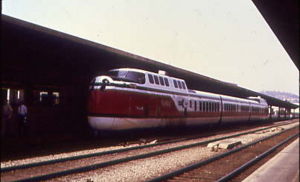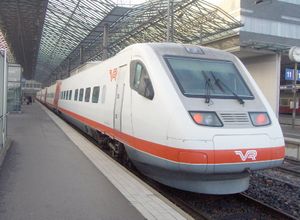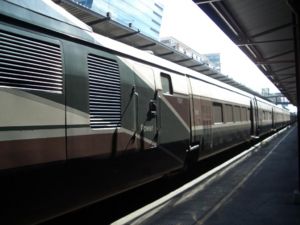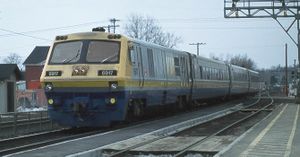Tilting train

A tilting train is a train with a tilting mechanism that enables increased speed on regular railroad tracks. As any vehicle rounds a curve at speed, independent objects inside it experience centrifugal force since their inherent momentum forward no longer lies along the line of the vehicle's course. This can cause packages to slide about on the floor, people seated in chairs to feel squashed against their outboard armrest, and standing passengers to lose their balance. Tilting trains are designed to counteract this discomfort. The most famous type of this category of trains is the Italian Pendolino.
Tilting trains are trains the upper part of which, where the passengers are seated, can be tilted sideways. In a curve to the left, it tilts to the left to compensate for the centrifugal push to the right, and vice versa.
The train may be constructed such that inertial forces themselves cause the tilting, commonly referred to as passive tilt, or it may be actively induced by a computer-controlled mechanism, referred to as active tilt.
Rationale
Aeroplanes and bicycles simply tilt in place; but automobiles and railway trains cannot do this on their own. To make their turns easier, the roadway of a high-speed highway or railway is canted inward around the curve. To a passenger in such a vehicle, the outward centrifugal force is countered by an inward gravitational one, thus removing the discomfort. (It should be noted that vehicles with high centers of gravity rounding very sharp curves at very high speeds may in fact topple over altogether; banking would also be the answer to counteract this threat. However, since passenger comfort becomes an issue at much lower speeds and gentler curves, railway designers, having kept their passengers comfortable, do not need to worry about trains overturning.)
The particular angle of tilt ("superelevation") is determined by the speed at which it is intended that vehicles will pass — faster speeds require more banking. But with a growing desire in the 1960s and 1970s to build high-speed rail networks, a problem arose: the amount of tilt appropriate for the new high-speed trains would be unacceptably over-tilted for slower-speed local passenger or freight trains which must share the lines. France, building its TGV, avoided the problem by building a special new rail network for the high-speed trains which minimized curves, likewise Japan's bullet train and many other high speed lines have necessitated new infrastructure.
Other countries, with less elbow room, weaker governmental planning powers, and more hilly terrain, were unable to follow. Specifically, Spain's national railway RENFE took a domestic invention, the TALGO, and developed it into a reliable high speed train for a low traffic density railway; British Railways (the UK state railway) invested heavily in tilting train technology to overcome the limitations of a rail network constructed through built-up areas early on in railway history when running speeds were very slow; and Italy's Trenitalia has invested heavily in tilting technology to speed trains through Italy's mountainous terrain.
Even though tilting trains are meant to help reduce the effects of centerfugial force on the human body, tilting trains can still cause nausea to anyone as they do not reduce the Coriolis effect on balancing systems. The effect could be felt under maximum speed and tilt, when the combination of the tilting outside view and lack of coresponding sideways forces can be very disconcerting to the passengers, like that of a "thrill ride". Researchers have found that if the tilting motion is reduced to compensate for only 80% or less of sideways forces, then passengers feel much more secure.
History
Santa Fe Pendulum-suspension car #1100
In 1938, Pullman built for the Atchison, Topeka and Santa Fe Railway an experimental pendulum-suspension "chair" car (coach) which saw service on the San Diegan passenger train, among others. Mounted on high springs, the car was to tilt inwards of curves to counterbalance the cant deficiency with the induced centrifugal force. However, as it relied on purely passive components, it was not entirely successful, and the lack of damping produced a sea-sickness inducing rolling motion that ensured that the experiment would not be repeated.
SNCF experiment
In 1956, the SNCF experimented with a self-propelled pendulum car, which also relied on centrifugal force. This experiment demonstrated the need for an active suspension system to tilt the coach bodies.
TALGO
The first successful European tilting train designs were imagined by TALGO in Spain, developed in the 1970s as a lightweight, fast train using passive tilt, but the first commercial service of these tilting trains really appeared in the beginning of the eighties, with the Canadian Turbo-Train as a second generation of TALGO. The TALGO is still in production in its 21st generation. TALGO trains are in service in various parts of Europe, and built under licence in Latin America and Asia. In North America, Amtrak uses TALGO trainsets in its Cascades service in the US Northwest, having earlier experimented with them in the Northeast Corridor.
Turbo-Train

The first tilting train to enter into regular service in North America was the United Aircraft Turbo train, used by Canadian National Railways, in 1969. Plagued with frequent breakdowns of its turbine power plants, it nevertheless assured daily service between Montreal and Toronto until it was retired in 1984, having been replaced by Bombardier LRC trains. United Aircraft Turbos were also used by Amtrak between Boston and New York in the early 1970s. The UAC Turbo had a passive tilt mechanism and they inspired the second generation of TALGO trains; its ride quality was rather mediocre due to the inadequate suspension use on the single axle trucks (bogies) between the cars, the tilt system required a direct connection between bogies and coaches.
Nevertheless, this was the first tilting system to enter commercial service in the world. None are in use now.
Pendolino

Another tilting train to enter into regular service was the Pendolino. The original ETR 401 train was built by FIAT in 1975 for the Italian State Railways following a prototype in 1970 and ran successfully for many years. The Pendolino project ticked over on a low budget developing a hypothetical successor until the early 80s when the go ahead was given to build a new fleet, which was the ETR 450. Later developments of this train (ETR 460 and ETR 480) have been very successful and are used throughout Europe. The latest development in this line is the ETR 610, which will enter service in Switzerland and Italy (and possibly Germany) in 2007/8 on the Cisalpino routes.
Advanced Passenger Train
In the 1970s and 1980s, following the success of its InterCity 125, British Rail built a tilting train called the Advanced Passenger Train. The APT-E (E for experimental) was powered by gas turbines and the APT-P (P for prototype) was electric. The train was advanced in both name and nature. Not only did it tilt, it had hydro-dynamic brakes, it was articulated and it had two power cars in the centre of the train. The latter was necessary because two power cars were deemed necessary for the proposed schedule but the use of a "roof-line" to send the 25kV supply along the train (and thus allow the power cars to be placed at the ends of the consist) was not acceptable at that time. Due to all this complexity the train was never reliable enough to go into service and so the project was scrapped, although some aspects of the technology were purchased by the Pendolino group to enlarge their portfolio. During tests some passengers reported that the tilting motion made them nauseous. Subsequently it was learned that this could be prevented by reducing the tilt slightly, so that there was still some sensation of cornering.
Much of the technology developed for the power cars was subsequently used in the InterCity225 (Class 91) trains which run on the East Coast route from London to Leeds and Edinburgh.
The Economist weekly wrote in its 21 February 1998 issue,"Tilt technology, to be sure, got off to a disastrous start in 1981. That was when British Rail (BR), Britain's old nationalised railway, had to withdraw its so-called Advanced Passenger Train after only three days of scheduled services. Passengers had complained of feeling sick, and there were many technical hitches with brakes and the state-of-the-art suspension. Since that unhappy debut, however, the technology has developed to a point where tilt trains are now being operated throughout Europe."
Light, Rapid, Comfortable
Canada's contribution is the LRC (Light, Rapid, Comfortable) train, built by Bombardier. This train is rather conventional, having separable carriages instead articulated trailers, and can be intermingled with conventional non-tilt cars. In the United States, Amtrak experimented with the LRC in 1980, but retired it a few years later. In Canada, it entered service in 1981, and the carriages remain in use today. The LRC tilt-mechanism is power-assisted, driven by accelerometers. The ride quality is very smooth, even on relatively low-end tracks. Bombardier have since used updated versions of the LRC carriages are for Deutsch Bahn ICE3 trains, Amtrak's Acela Express, the new generation of fast British Rail trains and the experimental JetTrain.
Deutsche Bahn 403 class
Another early train with tilting technology was Deutsche Bahn's class 403, used for airport transfers between Düsseldorf and Frankfurt which entered into service in 1978 (see also: AiRail Service). An attempt was made to use tilting technology to improve speeds on the extremely twisting Rhine Valley route. Shortly after the train went into service, the tilting technology was disabled as many passengers experienced motion sickness due to sudden and heavy tilting.
TGV Pendulaire
In 1998, the SNCF bowed to political pressure (the tilt-train was a credible threat to the TGV dedicated high-speed line network) and put in service an experimental TGV pendulaire. Following the test programme, it was converted back to a TGV-PSE train.
InterCity Neigezug

Switzerland got its first tilting train ever in its territory (discounting the Cisalpino, which entered Switzerland in 1996) on May 28, 2000. The ICN (InterCity Neigezug, or InterCity Tilting Train) entered service, running first from Geneva via Biel/Bienne and Zürich to St. Gallen. It was a major carrier in the national exhibition Expo.02.
In Japan
In Japan, the beginning of the usual operation of the tilting train is the operation of limited express "Shinano"(former name of Nagano) by 381 electric multiple unit in Chūō-saisen (central west line) of Japanese National Railways in 1972 . 381 was mass-produced based on data of 591 electric multiple unit that had been made for trial purposes in 1969. Though Japanese National Railways became the Japan Railways Group by being divided in 1987, the concept model of 2000 diesel multiple unit of JR Shikoku was produced in 1989, and in 1990 it was introduced (with 2000 mass production cars) into limited express "Shiokaze"(sea breeze) and "Nanpū"(south wind). The development of new cars (both electric and diesel) are continued, and introduction to new line districts are continued one by one. Moreover, the N700 electric multiple unit that becomes the first tilting train of Shinkansen is scheduled to mass-produce in 2007.
Technology
Many of the problems with motion sickness are related to the fact that a traditional servo system cannot respond instantaneously to the change in trajectory forces, and even slight discrepancies whilst not being noticeably perceivable cause nausea due to their unnatural nature. The original ETR 401 used individual gyroscopes in each carriage so there was inevitably a lag, even though nausea had not been a major problem with this train. The APT was supposed to supersede this problem by using gyroscopes at the ends of the train and a master slave control system which defined a "tilting curve" for the whole train. It would appear that the technology of the era was not able to implement this technique as well as required.
Modern tilting trains have the blessing of the latest signal processing technology which reads the line ahead and is able to anticipate a very precise control signal to the individual carriages and complaints about nausea have become a thing of the past.
Some tilting trains run on narrow-gauge lines. In Japan there are many narrow-gauge lines in mountainous regions, and tilting trains have been designed to run on these. In Australia the link between Brisbane and Cairns by the QR Tilt Train, which uses tilting trains, now claims to be the fastest narrow-gauge link in the world, running at 160km/h.
Tilting trains around the world
Trains with tilting by inertial forces:
- Talgo XXI (Spain)
- UAC Turbo (United States, Canada)
Trains with tilting controlled by accelerometers:
Trains with tilting controlled by a computer:
- Acela Express (United States), a Bombardier-built high-speed tilting train operating between Boston and Washington D.C.
- Advanced Passenger Train (United Kingdom), a British Rail project for high-speed inter-city tilting trains that saw limited service in the 1980s.
- ICE-T, also called ICT (Germany), a tilting version of the ICE
- ICN (Switzerland)
- InterCitySlovenija (Slovenia), a high-speed tilting train operating between Ljubljana, Maribor and Koper
- JetTrain (North America), Bombardier's experimental non-electric high-speed train
- ElettroTreno (Italy)
- Pendolino (Italy, Finland, United Kingdom, and Czech Republic), built by Alstom (formerly Fiat); see also British Rail Class 390
- The Tilt Train by Queensland Rail, diesel and electric tilting TravelTrains(Australia), the world's fastest narrow-gauge trains operating between Brisbane and Cairns
- X2 (Sweden), with tilting mechanism of ABB
- ICN trains in Croatia: Zagreb-Osijek, Zagreb-Varazdin, Zagreb-Split, Zagreb-Rijeka
External links
- Queensland High Speed Line
- Passive vs active tilting
- Tilting Trains
- Pendolino
- Photos of Japanese trains — some tilting
- Tilting trains — analysis and discussion
- Amtrak accelerates at last
- JR Hokkaido Tilting DMU
- Ride Comfort And Motion Sickness In Tilting Trains
de:Neigetechnik fr:Train pendulaire nl:Kantelbaktrein ja:振り子式車両 fi:Kallistuvakorinen juna zh:擺式列車



